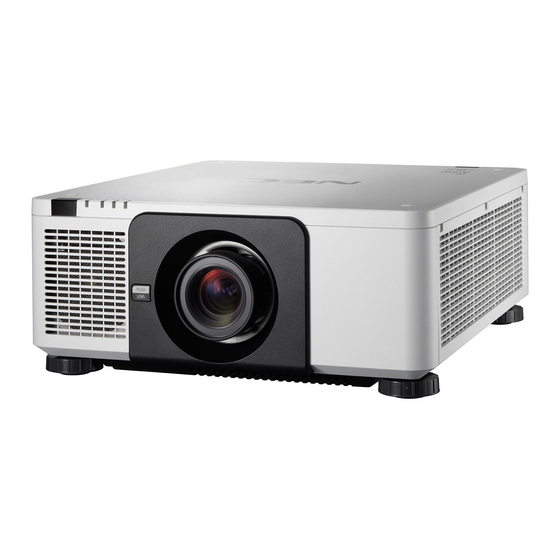
Table of Contents
Advertisement
Quick Links
Advertisement
Table of Contents

Summarization of Contents
1. Introduction
What's in the Box?
Lists all items included in the projector package for user verification.
Introduction to the Projector
Provides an overview of the projector's features, including resolution, brightness, and structure.
Part Names of the Projector
Details the physical components of the projector, such as lens, vents, and indicators.
Controls and Indicator Panel
Explains the function of each button and indicator light on the projector's control panel.
Terminals Features
Describes the various input and output ports available on the projector for connectivity.
Part Names of the Remote Control
Identifies and explains the function of each button on the projector's remote control.
2. Projecting an Image (Basic Operation)
Flow of Projecting an Image
Outlines the step-by-step process for setting up and projecting an image with the projector.
Connecting Your Computer/Power Cord
Guides users on how to connect a computer and the power cord to the projector.
Turning on the Projector
Details the procedure for powering on the projector, including standby mode and indicators.
Performing Lens Calibration
Explains how to calibrate the lens for optimal zoom, focus, and shift after installation.
3. Convenient Features
Lens Shutter and Image Muting
Covers functions like turning off the light source and temporarily hiding the image (AV-MUTE).
Magnifying a Picture
Describes how to enlarge the projected image up to four times using the D-ZOOM function.
Changing Light Mode and Energy Saving
Explains how to adjust the projector's light mode for energy saving and check its effects.
Correcting Keystone Distortion
Details how to correct trapezoidal distortion for horizontal and vertical keystone correction.
Preventing Unauthorized Use (Security)
Guides on setting a keyword to prevent unauthorized operation of the projector.
Projecting 3D Videos
Explains the procedure and precautions for watching 3D videos with the projector.
Controlling the Projector via HTTP Browser
Describes how to operate the projector remotely using a web browser over a network.
Network Settings Configuration
Details how to configure wired LAN settings, including IP address, DHCP, and profiles.
Storing Lens Adjustments
Explains how to save and recall lens adjustments using REF. LENS MEMORY and LENS MEMORY.
4. Multi-Screen Projection
Multi-Screen Projection Capabilities
Introduces multi-screen projection using single or multiple projectors for larger displays.
Displaying Two Pictures Simultaneously
Details how to use PIP and PICTURE BY PICTURE modes to display two different signals at once.
Displaying Pictures Using Edge Blending
Explains how to combine multiple projectors to create a seamless large screen with edge blending.
5. Using On-Screen Menu
Navigating the On-Screen Menus
Guides users on how to access and navigate through the projector's on-screen menu system.
Understanding Menu Elements
Identifies and explains the various components found within the projector's on-screen menus.
List of Menu Items and Options
Provides a comprehensive list of all available menu items and their corresponding settings.
Menu Descriptions & Functions [INPUT]
Details the functions and descriptions for each input source selection available on the projector.
Menu Descriptions & Functions [ADJUST]
Explains the various picture adjustment settings, including mode, presets, and detail settings.
Menu Descriptions & Functions [SETUP]
Covers setup options like language, color select, input display, and 3D caution messages.
Power Options Settings
Explains standby mode, direct power on, auto power off, and off timer settings for power management.
Reset to Factory Default
Details how to reset projector settings to factory defaults for current signal or all data.
6. Installation and Connections
Mounting a Lens (sold separately)
Guides on how to attach and remove optional lenses, including calibration steps.
Analog RGB Signal Connection
Details connecting a computer using analog RGB signals via VGA or BNC cables.
Digital RGB Signal Connection
Explains connecting computers using HDMI or DisplayPort cables for digital signals.
Connecting to a Wired LAN
Guides on setting up a LAN connection using the projector's Ethernet/HDBaseT port.
Connecting to an HDBaseT Transmission Device
Explains connecting the projector to HDBaseT devices for signal and control.
Portrait Projection (Vertical Orientation)
Details how to install the projector vertically for portrait image display.
Stacking Projectors
Explains how to stack projectors for increased brightness and the precautions involved.
7. Maintenance
Cleaning the Lens
Provides instructions for safely cleaning the projector's lens without scratching it.
Cleaning the Cabinet
Guides on how to clean the projector's exterior cabinet and ventilation slits.
8. Appendix
Throw Distance and Screen Size
Offers tables and calculations for determining throw distance based on screen size and lens.
Specifications
Provides detailed technical specifications of the projector, including dimensions and power.
Option Lens Specifications
Lists specifications for various optional lenses, including throw ratio and image size.
Mounting the Optional Board (sold separately)
Guides on installing optional boards into the projector's slot, ensuring correct orientation.
Compatible Input Signal List
Lists supported analog computer, component video, and composite video/S-video signals.
Troubleshooting Indicator Messages
Explains power, status, light, and temperature indicator messages for troubleshooting.
Common Problems & Solutions
Lists common issues like no picture, dark image, or remote not working with possible solutions.
Troubleshooting Check List
Provides a checklist to help diagnose and confirm if repairs are needed before contacting support.








Need help?
Do you have a question about the PX1004UL-BK and is the answer not in the manual?
Questions and answers